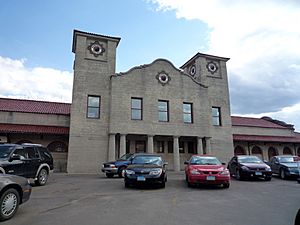Bismarck, North Dakota facts for kids
Quick facts for kids
Bismarck, North Dakota
|
||
|---|---|---|
| City of Bismarck | ||
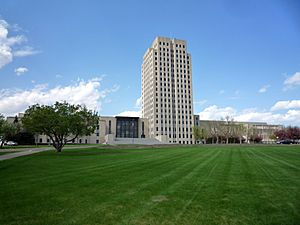
|
||
|
||
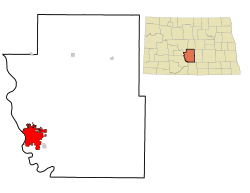
Location within Burleigh County in North Dakota
|
||
| Country | United States | |
| State | North Dakota | |
| County | Burleigh | |
| Founded | May 14, 1872 | |
| Named for | Otto von Bismarck | |
| Area | ||
| • State capital city | 34.80 sq mi (90.12 km2) | |
| • Land | 34.30 sq mi (88.83 km2) | |
| • Water | 0.50 sq mi (1.29 km2) | |
| Elevation | 1,686 ft (514 m) | |
| Population
(2020)
|
||
| • State capital city | 73,622 | |
| • Rank | US: 496th ND: 2nd |
|
| • Density | 2,143.83/sq mi (827.75/km2) | |
| • Urban | 81,955 (349th) | |
| • Metro | 133,626 (308th) | |
| Time zone | UTC-6 (CST) | |
| • Summer (DST) | UTC-5 (CDT) | |
| ZIP codes |
58501–58507
|
|
| Area code(s) | 701 | |
| FIPS code | 38-07200 | |
| GNIS feature ID | 1035849 | |
Bismarck is the capital of the U.S. state of North Dakota and the county seat of Burleigh County. It is the second-most populous city in North Dakota after Fargo. The city's population was 73,622 in the 2020 census, while its metropolitan population was 133,626. In 2020, Forbes magazine ranked Bismarck as the seventh fastest-growing small city in the United States.
Bismarck was founded by European-Americans in 1872 on the east bank of the Missouri River. It has been North Dakota's capital city since 1889, when the state was created from the Dakota Territory and admitted to the Union.
Bismarck is across the river from Mandan, named after a historic Native American tribe of the area. The two cities make up the core of the Bismarck–Mandan Metropolitan Statistical Area.
The North Dakota State Capitol is in central Bismarck. The state government employs more than 4,600 in the city. As a hub of retail and health care, Bismarck is the economic center of south-central North Dakota and north-central South Dakota.
Contents
History
For thousands of years, present-day central North Dakota was inhabited by indigenous peoples, who created successive cultures. The historic Mandan Native American tribe occupied the area long before Europeans arrived. They spoke the Hidatsa language. The Hidatsa name of Bismarck is mirahacii arumaaguash ("Place of the tall willows"); the Arikara name is ituhtaáwe [itUhtaáwe].
In 1872 European Americans founded a settlement at what was then called Missouri Crossing, so named because the Lewis and Clark Expedition crossed the river there on their exploration of the Louisiana Purchase in 1804-1806. It had been an area of Mandan settlement. Later the new town was called Edwinton, after Edwin Ferry Johnson (1803–1872), engineer-in-chief for the Northern Pacific Railway. Its construction of railroads in the territory attracted workers and settlers.
In 1873, the Northern Pacific Railway renamed the city as Bismarck, in honor of German chancellor Otto von Bismarck. Railroad officials hoped to attract German immigrant settlers to the area and German investment in the railroad. The discovery of gold in the nearby Black Hills of South Dakota the following year was a greater impetus for growth. Thousands of miners came to the area, encroaching on what the Lakota considered sacred territory and leading to heightened tensions with the Native Americans. Bismarck became a freight-shipping center on the "Custer Route" from the Black Hills. In 1883 Bismarck was designated as the capital of the Dakota Territory, and in 1889 as the state capital of the new state of North Dakota.
Geography
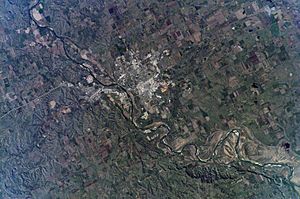
Bismarck is located at 46°48′48″N 100°46′44″W / 46.81333°N 100.77889°W (46.813343, −100.779004).
According to the United States Census Bureau, the city has a total area of 31.23 square miles (80.89 km2), of which, 30.85 square miles (79.90 km2) is land and 0.38 square miles (0.98 km2) is water.
Cityscape
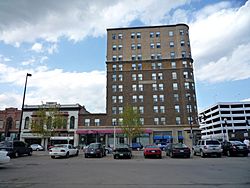
The city has developed around downtown Bismarck, the center of historic development. It is distinctive because the city's major shopping center, Kirkwood Mall, is located in the center city rather than in the suburbs. Several other major retail stores are in the vicinity of Kirkwood Mall, which was developed near the Bismarck Civic Center. The two Bismarck hospitals, St. Alexius Medical Center and Sanford Health (previously Medcenter One Health Systems) are both downtown. The streets are lined with small stores and restaurants, providing numerous amenities.
Much recent commercial and residential growth has taken place in the northern section of the city, largely because of expanding retail centers. Among the shopping centers in northern Bismarck are Gateway Fashion Mall, Northbrook Mall, Arrowhead Plaza, and the Pinehurst Square "power center" mall.
The North Dakota State Capitol complex is just north of downtown Bismarck. The 19-story Art Deco capitol is the tallest building in the city and the state, at a height of 241.75 feet (73.69 m). The capitol building towers over the central part of the city and is easily seen from 20 miles (32 km) away on a clear day. Completed during the Great Depression in 1934, it replaced an earlier capitol building that burned to the ground in 1930. The capitol grounds house the North Dakota Heritage Center, the North Dakota State Library, the North Dakota Governor's Residence, the State Office Building, and the Liberty Memorial Building. The North Dakota State Penitentiary is in eastern Bismarck.
The Cathedral District is an historic neighborhood near downtown Bismarck. The neighborhood was named after the art deco Cathedral of the Holy Spirit. Some homes in this neighborhood date to the 1880s, although many were built in the first decades of the 20th century. At times, the city has proposed widening the streets in the neighborhood to improve traffic flow. Many residents object because such a project would require the removal of many of the towering American elms which line the streets. These have escaped the elm disease that destroyed street canopies of trees in Eastern cities.
After the completion of Garrison Dam in 1953 by the Army Corps of Engineers, which improved flood control, the floodplain of the Missouri River became a more practical place for development. Significant residential and commercial building has taken place in this area on the south side of the city. The Upper Missouri River is still subject to seasonal flooding.
Climate
Situated in the middle of the Great Plains, between the geographic centers of the United States and Canada, Bismarck displays a highly variable four-season humid continental climate (Köppen Dfb) with strong semi-arid influences. Bismarck's climate is characterized by long, cold, somewhat snowy and windy winters, and hot summers that are at times humid. Thunderstorms occur in spring and summer, but much of the rest of the year is dry.
The warmest month in Bismarck is July, with a daily mean of 21.3 °C (70.3 °F), with typically wide variations between day and night. The coldest month is January, with a 24-hour average of −12.1 °C (10.2 °F). Precipitation peaks from May to September and is rather sparse in the winter months. Winter snowfall is typically light to moderate, occurring with the passage of frontal systems; major storms are rare.
| Climate data for Bismarck Municipal Airport, North Dakota (1981–2010 normals, extremes 1874–present) | |||||||||||||
|---|---|---|---|---|---|---|---|---|---|---|---|---|---|
| Month | Jan | Feb | Mar | Apr | May | Jun | Jul | Aug | Sep | Oct | Nov | Dec | Year |
| Record high °F (°C) | 63 (17) |
73 (23) |
81 (27) |
93 (34) |
102 (39) |
111 (44) |
114 (46) |
109 (43) |
105 (41) |
95 (35) |
79 (26) |
66 (19) |
114 (46) |
| Average high °F (°C) | 23.4 (−4.8) |
28.3 (−2.1) |
40.4 (4.7) |
57.0 (13.9) |
68.4 (20.2) |
77.2 (25.1) |
84.7 (29.3) |
83.5 (28.6) |
72.1 (22.3) |
57.5 (14.2) |
39.6 (4.2) |
26.2 (−3.2) |
54.9 (12.7) |
| Daily mean °F (°C) | 12.8 (−10.7) |
18.1 (−7.7) |
29.9 (−1.2) |
43.8 (6.6) |
55.5 (13.1) |
64.7 (18.2) |
71.1 (21.7) |
69.5 (20.8) |
58.5 (14.7) |
44.8 (7.1) |
29.2 (−1.6) |
16.2 (−8.8) |
42.8 (6.0) |
| Average low °F (°C) | 2.2 (−16.6) |
7.9 (−13.4) |
19.4 (−7.0) |
30.7 (−0.7) |
42.7 (5.9) |
52.0 (11.1) |
57.4 (14.1) |
55.5 (13.1) |
44.9 (7.2) |
32.2 (0.1) |
18.8 (−7.3) |
6.1 (−14.4) |
30.8 (−0.7) |
| Record low °F (°C) | −45 (−43) |
−45 (−43) |
−36 (−38) |
−12 (−24) |
13 (−11) |
30 (−1) |
32 (0) |
32 (0) |
10 (−12) |
−10 (−23) |
−30 (−34) |
−43 (−42) |
−45 (−43) |
| Average precipitation inches (mm) | 0.43 (11) |
0.51 (13) |
0.87 (22) |
1.26 (32) |
2.40 (61) |
3.17 (81) |
2.89 (73) |
2.28 (58) |
1.59 (40) |
1.25 (32) |
0.71 (18) |
0.49 (12) |
17.85 (453) |
| Average snowfall inches (cm) | 8.9 (23) |
8.1 (21) |
9.1 (23) |
4.2 (11) |
0.4 (1.0) |
0 (0) |
0 (0) |
0 (0) |
0.2 (0.51) |
2.2 (5.6) |
8.8 (22) |
9.3 (24) |
51.2 (130) |
| Average precipitation days (≥ 0.01 in) | 7.5 | 7.0 | 7.9 | 7.4 | 10.1 | 11.2 | 9.7 | 8.2 | 7.5 | 6.6 | 7.0 | 7.6 | 97.7 |
| Average snowy days (≥ 0.1 in) | 9.7 | 8.1 | 6.4 | 2.5 | 0.4 | 0 | 0 | 0 | 0.1 | 1.4 | 6.6 | 10.0 | 45.2 |
| Average relative humidity (%) | 71.3 | 72.4 | 69.9 | 61.8 | 60.1 | 65.0 | 61.8 | 60.6 | 63.7 | 63.8 | 72.0 | 74.5 | 66.4 |
| Mean monthly sunshine hours | 149.4 | 153.5 | 222.3 | 244.3 | 296.1 | 318.1 | 354.6 | 316.2 | 245.9 | 191.7 | 122.6 | 122.9 | 2,737.6 |
| Percent possible sunshine | 53 | 53 | 60 | 60 | 64 | 67 | 74 | 72 | 65 | 57 | 43 | 46 | 61 |
| Source: NOAA (relative humidity and sun 1961–1990), The Weather Channel | |||||||||||||
Demographics
| Historical population | |||
|---|---|---|---|
| Census | Pop. | %± | |
| 1880 | 1,758 | — | |
| 1890 | 2,186 | 24.3% | |
| 1900 | 3,319 | 51.8% | |
| 1910 | 4,913 | 48.0% | |
| 1920 | 7,122 | 45.0% | |
| 1930 | 11,090 | 55.7% | |
| 1940 | 15,496 | 39.7% | |
| 1950 | 18,541 | 19.7% | |
| 1960 | 27,670 | 49.2% | |
| 1970 | 34,703 | 25.4% | |
| 1980 | 44,485 | 28.2% | |
| 1990 | 49,256 | 10.7% | |
| 2000 | 55,532 | 12.7% | |
| 2010 | 61,272 | 10.3% | |
| 2020 | 73,622 | 20.2% | |
| U.S. Decennial Census 2020 Census |
|||
2020
As of the census of 2020, there were 73,622 people and 32,044 households residing in the city. The racial makeup of the city was 89.8% White, 2.7% African American, 4.3% Native American, 0.9% Asian, 0.1% from Native Hawaiian, and 1.8% from two or more races. Hispanic or Latino of any race were 2.5% of the population.
There were 32,044 households, the average household size of which was 2.2.
6.7% of residents were under the age of five; 21.8% of residents were between the ages of six and 18; 17% of residents were over the age of 65. The gender makeup of the city was 49.6% male and 50.4% female.
2010
As of the census of 2010, there were 61,272 people, 27,263 households, and 15,624 families residing in the city. The population density was 1,986.1 inhabitants per square mile (766.8/km2). There were 28,648 housing units at an average density of 928.6 per square mile (358.5/km2). The racial makeup of the city was 92.4% White, 0.7% African American, 4.5% Native American, 0.6% Asian, 0.3% from other races, and 1.5% from two or more races. Hispanic or Latino of any race were 1.3% of the population. In terms of ancestry, 56.1% were of German, 20.5% were of Norwegian, 7.2% were of Irish, 6.7% were of Russian, 3.7% were of American, 3.6% were of English descent.
There were 27,263 households, of which 27% had children under the age of 18 living with them (the lowest percentage in North Dakota), 44.1% were married couples living together, 9.6% had a female householder with no husband present, 3.6% had a male householder with no wife present, and 42.7% were non-families. 34.8% of all households were made up of individuals, and 11.7% had someone living alone who was 65 years of age or older. The average household size was 2.18 and the average family size was 2.82.
The median age in the city was 38 years. 20.8% of residents were under the age of 18; 11% were between the ages of 18 and 24; 26.2% were from 25 to 44; 26.8% were from 45 to 64; and 15.4% were 65 years of age or older. The gender makeup of the city was 48.6% male and 51.4% female.
2000
At the time of the 2000 Census, there were 55,532 people, 23,185 households, and 14,444 families residing in the city. The population density was 2,065.2 per square mile (797.4/km2). There were 24,217 housing units at an average density of 900.6 per square mile (347.7/km2). The racial makeup of the city was 94.78% White, 3.39% Native American, 0.89% from two or more races, 0.75% Hispanic or Latino, 0.45% Asian, 0.28% Black or African American, 0.17% from other races and 0.03% Pacific Islander.
There were 23,185 households, of which 30.2% had children under the age of 18 living with them, 50.1% were married couples living together, 9.3% had a female householder with no husband present, and 37.7% were non-families. 31.0% of all households were made up of individuals, and 10.5% were someone living alone who was 65 years of age or older. The average household size was 2.32 and the average family size was 2.94.
In the city, the population was spread out, with 23.5% under the age of 18, 11.1% from 18 to 24, 29.1% from 25 to 44, 22.4% from 45 to 64, and 13.8% who were 65 years of age or older. The median age was 36 years. For every 100 females, there were 93.9 males. For every 100 females age 18 and over, there were 91.8 males.
The median income per household in the city was $39,422, and the median income per family was $51,477. Males had a median income of $33,804 versus $22,647 for females. The per capita income for the city was $20,789. About 5.7% of families and 8.4% of the population were below the poverty line, including 9.5% of those under age 18 and 7.4% of those age 65 or over.
Culture
The Belle Mehus Auditorium, a 1914 historic building in downtown Bismarck, is a center for the arts in the area. Performances of Northern Plains Dance and the Bismarck-Mandan Symphony Orchestra are held there.
Theater companies in Bismarck include the Capitol Shakespeare Society, Sleepy Hollow Summer Theatre, the Shade Tree Players children's theater group, Dakota Stage Ltd, University of Mary, Bismarck State College, and various high school groups. The Gannon and Elsa Forde Art Galleries are at Bismarck State College. The Missouri Valley Chamber Orchestra, founded in 2000, is the community's newest orchestra and performs a variety of musical genres.
Recreation
Bismarck has a large park system and an extensive network of exercise trails. The Bismarck Parks and Recreation District, established in 1927, operates many parks, swimming pools, and several golf courses within the city. The Parks and Recreation District operates roughly 2,300 acres (930 ha) of public parkland. Sertoma Park stretches more than 3 miles (4.8 km) along the banks of the Missouri River. Within the park are several miles of biking trails and the Dakota Zoo.
There are five golf courses in Bismarck: four 18-hole courses (Apple Creek Country Club, Hawktree Golf Club, Riverwood Golf Course, and Tom O'Leary Golf Course), and one 9-hole course (Pebble Creek Golf Course).
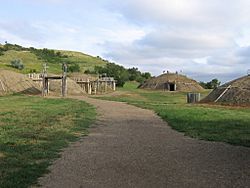
One of the main tourism attractions of the Bismarck area is Fort Abraham Lincoln State Park, located 7 miles (11 km) south of neighboring Mandan, North Dakota. It contains the partial reconstruction of Fort Abraham Lincoln, the headquarters of the 7th Cavalry and last command of General George Armstrong Custer before the Battle of the Little Bighorn (also known as the Battle of the Greasy Grass). The park includes On-a-Slant Village, a partially rebuilt earth lodge village that was once occupied by people of the historic Mandan tribe. Guided tours of both sites are offered in the summertime. There are also a museum on park history, nature trails, and a campground.
Hunting and fishing are popular in the area, with hunting seasons for deer, pheasant, and waterfowl. Fishing is a year-round sport on the Missouri River bordering Bismarck, and there are public docks on the river. From north to south, there is a dock at the Port of Bismarck, from which the Lewis and Clark passenger riverboat plies the Missouri; Fox Island Landing, about a half mile southwest of Riverwood Golf Course; and the Bismarck Dock at General Sibley Park, which has a boat ramp and picnic facilities.
Near Bismarck are several dammed lakes, including McDowell Dam Lake, 6 miles (9.7 km) east of the city; Harmon Lake, 8 miles (13 km) north of neighboring Mandan on the west side of the river; and two lakes several miles west of the city.
In February 2007, Bismarck broke the record for the most snow angels made in one place. A total of 8,962 participants came to the capitol grounds for the event.
Infrastructure
Transportation
The Capital Area Transit System (CAT) began operations in May 2004. This public bus system is operated by the Bis-Man Transit Board and has eleven routes throughout Bismarck and Mandan, Monday-Saturday. Bis-Man Transit also operates a para-transit service for senior citizens and people with disabilities.
Bismarck Municipal Airport is south of the city. It has the largest passenger volume in western North Dakota and the second highest within the state. The airport is served by United Express, Allegiant Air, Delta Air Lines, American Airlines, and Frontier Airlines. A new $15 million terminal opened in May 2005. The previous terminal was built in the mid-1960s and expanded in the mid-1970s. After a windstorm collapsed part of the roof connecting the expanded terminal to the original building, officials decided to demolish the entire complex and build the new terminal.
The BNSF Railway runs east–west through the city. The railway was originally integral to the growth of Bismarck and Mandan. Today it is used for freight. Due to restructuring in the railroad industry, there has not been passenger train service in Bismarck since Amtrak's North Coast Hiawatha service ended in 1979. The closest Amtrak station is in Minot, north of Bismarck, which is served by the Empire Builder.
Two federal highways pass through Bismarck. Interstate 94 runs east–west through the city. The north–south U.S. Route 83 merges in north Bismarck with Interstate 94 and runs east for roughly 25 miles (40 km) before turning south.
Bismarck had electric streetcar service from 1904 to 1931.
Economy
According to the city's 2017 Comprehensive Annual Financial Report, the largest employers in the city are the following:
| # | Employer | # of Employees |
|---|---|---|
| 1 | State of North Dakota | 4,600 |
| 2 | Sanford Health | 3,284 |
| 3 | Bismarck Public Schools | 2,187 |
| 4 | CHI St. Alexius Medical Center | 2,044 |
| 5 | United States Government Offices | 1,200 |
| 6 | Bismarck State College | 719 |
| 7 | Walmart North/South | 665 |
| 8 | Aetna | 618 |
| 9 | University of Mary | 642 |
| 10 | City of Bismarck | 631 |
| 11 | MDU Resources | 592 |
| 12 | Bobcat/Doosan Company | 582 |
| 13 | Missouri Slope Lutheran Care Center | 560 |
| 14 | Basin Electric Power Cooperative | 560 |
| 15 | Coventry Health Care | 550 |
| 16 | Mid Dakota Clinic | 540 |
Sports
Amateur
High school and college sports are the main feature of the local athletics landscape. The athletic teams at the three public Bismarck high schools, Bismarck High School, Century High School, and Legacy High School, are known as The Demons, The Patriots, and The Sabers, respectively. The athletic teams at St. Mary's Central High School, Bismarck's Catholic high school, are known as The Saints. The teams at Bismarck State College and United Tribes Technical College are known as The Mystics and Thunderbirds, and both compete in the National Junior College Athletic Association. The teams at the University of Mary are The Marauders and compete in the Northern Sun Intercollegiate Conference. Bismarck has an American Legion baseball team called the Governors.
In the fall, the accent is on high school and college football. There are spirited rivalries among the several high schools in the area. The University of Mary added the sport in 1988. Most University of Mary football games are played in the Community Bowl. Other popular sports during the winter months include ice hockey, wrestling and basketball.
In spring, baseball is one of the top amateur sports in the city with each high school, Bismarck State College, and The University of Mary providing teams. The University of Mary also has a softball team. High schools and colleges also feature track and field during the spring.
In the summer, Bismarck has American Legion baseball and auto racing. The Fourth of July holiday is the height of rodeo time, with rodeos in Mandan and Bismarck. Slow-pitch softball is played by teams in the city. Bismarck is the host city of the world's largest charity softball tournament, the Sam McQuade Sr. Softball Tournament, in which more than 400 teams from all over the United States and Canada compete.
The Bismarck Bobcats hockey team of the North American Hockey League is made up of junior players (age twenty and younger, sometimes age twenty-one if waived). The Bobcats won back-to-back Borne Cup championships as members of the America West Hockey League before merging into the NAHL in 2003. The Bobcats have made several trips to the NAHL's national tournament, claiming their first-ever Robertson Cup title in 2010.
Since 2017, the Bismarck Larks, a Northwoods League expansion baseball team, has played their home games at the Bismarck Municipal Ballpark.
Professional
The Dakota Wizards of the NBA Development League was formerly based in Bismarck. The Wizards' first season took place in 1995 in the International Basketball Association. The Wizards won one title during their International Basketball Association days (1995–2001) and two during their Continental Basketball Association days (2001–2006). They were the 2006–07 champions of the NBA D-League, their first season in the league. The team moved to Santa Cruz, California, in 2012, a year after being purchased by the Golden State Warriors of the National Basketball Association.
Starting with the 2017 season, Bismarck is home to the Bismarck Bucks, a professional indoor football team in the Indoor Football League. Bismarck has been the home of two professional indoor football teams, the Bismarck Blaze and the Bismarck Roughriders, but both teams left the city soon after they were formed.
Bismarck once had a professional baseball team, the Dakota Rattlers, but the team moved to Minot after several seasons in Bismarck.
Education
Elementary, middle and high schools
The Bismarck Public Schools system operates sixteen elementary schools, three middle schools (Simle, Wachter, Horizon), three public high schools (Century High, Legacy High School, and Bismarck High) and one alternative high school (South Central High School). The system educates 13,350 students and employs 1,500 people.
Three Bismarck Catholic parishes operate primary schools (kindergarten through eighth grade): St. Mary's Grade School, St. Anne's Grade School, and Cathedral Grade School. St. Mary's Grade School, founded in 1878, is the oldest continuously operating elementary school in North Dakota.
The city has three private high schools: the Catholic St. Mary's Central High School, Shiloh Christian School, operated by Protestants, and Dakota Adventist Academy.
Higher education
There are three colleges and a university in Bismarck. The University of Mary is a four-year university, operated by the Benedictine Sisters of Annunciation Monastery. Bismarck State College is a two-year public college, the largest degree-granting institution in the city, and a member of the North Dakota University System. United Tribes Technical College is a two-year tribal college. Sanford Health, formerly Medcenter One, operates a nursing school that offers a Bachelor of Science in Nursing. The campus is just north of the medical center in central Bismarck.
Notable people
- Sam Aanestad, dentist and California state legislator
- David Andahl, businessman and politician
- Shane Balkowitsch, American wet plate photographer
- Leslie Bibb, actress
- Paula Broadwell, a consultant and author and extramarital partner of General David Petraeus.
- John Burke, state Supreme Court Justice, tenth governor of North Dakota, 24th Treasurer of the United States
- Gary Cederstrom, Major League Baseball umpire
- Neil Churchill, Bismarck mayor
- Dale Clausnitzer, Minnesota state legislator and businessman
- Kent Conrad, U.S. Senator
- Ronnie Cramer, artist, filmmaker
- Dale DeArmond, printmaker and book illustrator
- Weston Dressler, Saskatchewan Roughriders slotback
- Shannon Galpin, founder of "Strength in Numbers"
- Linnea Glatt, post-modern sculptor and installationist
- John Hoeven, U.S. Senator, (since 2011) 31st Governor of North Dakota (2005–2010)
- Clay Jenkinson, Author, Thomas Jefferson scholar.
- Thomas S. Kleppe, former Bismarck mayor, 41st U.S. Secretary of the Interior
- Brock Lesnar, wrestler and former heavyweight UFC champion
- Cara Mund, Miss America 2018
- Mike Peluso, right wing with the Chicago Blackhawks and Philadelphia Flyers
- John Andrew Rea, newspaper editor, helped draft the state constitution
- Mel Ruder, Pulitzer Prize winning journalist
- Ed Schafer, 30th Governor of North Dakota, 29th U.S. Secretary of Agriculture
- Jonathan Twingley, artist, illustrator and novelist
- Carson Wentz, professional football player for the Washington Commanders
See also
 In Spanish: Bismarck (Dakota del Norte) para niños
In Spanish: Bismarck (Dakota del Norte) para niños




